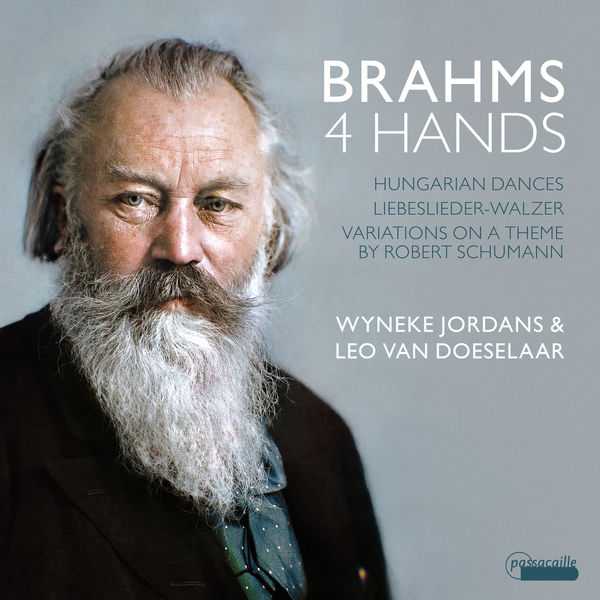

Composer: Johannes Brahms
Performer: Wyneke Jordans, Leo van Doeselaar
Format: FLAC (tracks)
Label: Passacaille
Catalogue: PAS1089
Release: 2021
Size: 1.04 GB
Recovery: +3%
Scan: yes
21 Hungarian Dances, WoO 1
01. No. 1 in G Minor (Allegro molto)
02. No. 2 in D Minor (Allegro non assai)
03. No. 3 in F Major (Allegretto)
04. No. 4 in F Minor (Poco sostenuto)
05. No. 5 in F-Sharp Minor (Allegro)
Variations on a Theme by Robert Schumann in E-Flat Major, Op. 23
06. Thema (Leise und innig)
07. Variation I (L’istesso tempo Andante molto moderato)
08. Variation II
09. Variation III
10. Variation IV
11. Variation V (Poco più animato)
12. Variation VI (Allegro non troppo)
13. Variation VII (Con moto. L’istesso tempo)
14. Variation VIII (Poco più vivo)
15. Variation IX
16. Variation X (Molto moderato, alla marcia)
Liebeslieder Waltzes, Op. 52a (arr. piano 4-hands)
17. No. 1 (Im Ländler-Tempo)
18. No. 2
19. No. 3
20. No. 4
21. No. 5
22. No. 6 (Grazioso)
23. No. 7
24. No. 8
25. No. 9
26. No. 10
27. No. 11
28. No. 12
29. No. 13
30. No. 14
21 Hungarian Dances, WoO 1
31. No. 15
Liebeslieder Waltzes, Op. 52a (arr. piano 4-hands)
32. No. 16 (Lebhaft)
33. No. 17 (Mit Ausdruck)
34. No. 18 (Lebhaft)
21 Hungarian Dances, WoO 1
35. No. 8 in A Minor (Presto)
36. No. 11 in D Minor (Poco andante)
37. No. 13 in D Major (Andantino grazioso)
Johannes Brahms composed only a small number of original works for piano four hands, but arranged almost all of his chamber music and orchestral works for this instrumentation. He played most of them immediately after their completion with Clara Schumann and greatly appreciated her opinion.
In his Hungarian Dances Brahms brilliantly transformed original Hungarian melodies and rhythms into multi-coloured orchestral works. The Blüthner grand piano from 1867 shows how Brahms made perfect use of the entire keyboard in his writing for four hands. The various registers appear completely transparent and clear. It is not generally known that Brahms was a great admirer and friend of Johann Strauss. And he loved waltzes! Thus Brahms also created an instrumental version of his Liebeslieder-Walzer for piano four hands.
Robert Schumann’s last theme, which he wrote for his so-called “Ghost Variations” immediately before being admitted to a mental hospital, is used by Brahms in his homage to Schumann, which was written immediately after his death in 1856: the Variations on a Theme by Robert Schumann, Op. 23 for piano four hands, which ends with an impressive funeral march.
For the piano duo Wyneke Jordans & Leo van Doeselaar it was an obvious choice to conclude their series with recordings of four-handed piano works by great German composers on period instruments with Brahms.



